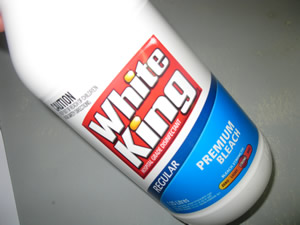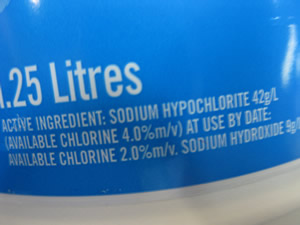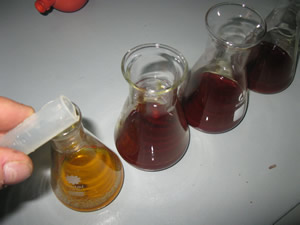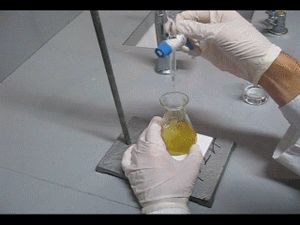
To determine the 'available chlorine' in household bleach by redox titration.
SAFETY
- Wear safety glasses, gloves and a laboratory coat for this experiment.
- Avoid contact of bleach or sulfuric acid with skin, eyes or clothing.
- Household bleach, sodium thiosuffate and potassium iodide may cause irritation to the skin and eyes. Avoid contact.
Duration 45 minutes
Material
20 mL household bleach, 15 mL of 1 M potassium iodide solution, 15 mL of 1 M sulfuric acid, 100 mL standard sodium thiosulfate solution, approximately 0.1 M starch indicator solution, 90 mL distilled water, 250 mL volumetric flask, 2 x 20 mL pipettes, pipette filler, 3 x 100 mL conical flasks, 10 mL measuring cylinder, burette and stand, small funnel, white tile, safety glasses
Theory
Household bleach is manufactured by passing an electric current through brine, a concentrated solution of sodium chloride. Chlorine and sodium hydroxide are produced and react to form a mixture of sodium hypochlorite and sodium chloride:
Cl2(aq) + 2NaOH(aq) => NaOCl(aq) + NaCl(aq) + H2O(l)
The decolourising effect of bleach is due to the action of the hypochlorate ion (OCl-) as an oxidant. The concentration of the sodium hypochlorate in a bleach is recorded as its ‘available chlorine'. The available chlorine is usually expressed on the label of the bottle of bleach as a percentage of weight/volume (w/v) or weight/weight (w/w)
In this analysis, the hypochlorite ion in a sample of bleach is reacted with an excess of iodide ions. Iodine is a product of the reaction:
OCl–(aq) + 2I–(aq) + 2H+(aq) => I2(aq) + Cl–(aq) + H2O(l)
The amount of iodine produced is then determined by titration with standard sodium thiosulfate solution:
I2(aq) + 2S2O32–(aq) => S4O62–(aq) +2I–(aq)
Since starch turns blue in the presence of iodine, it is used as all indicator for this final reaction.
Procedure
1 |
Record the brand of household bleach to be analysed and the manufacturer's specifications as to available chlorine content. |
 |
2 |
Use a pipette to dispense 20.00 mL of the bleach into a 250 mL volumetric flask. Use distilled water to make up the solution to the calibration line of the flask and mix thoroughly. |
|
3 |
Using a pipette, transfer a 20.00mL volume of the diluted bleach solution to each of three 100 mL conical flasks. |
|
4 |
Fill a burette with standard sodium thiosulphate solution. Record the initial volume of liquid in the burette and the concentration of the sodium thiosulphate solution. |
|
5 |
To each flask, add about 5 mL of 1 M potassium iodide solution and aboul 5 mL of 1 M sulfuric acid. The solution will turn dark brown as iodine is formed. |
 |
6 |
Titrate each mixture with the sodium thiosulfate solution until the yellow-brown colour of the iodine has become pale, then add 1-2 mL of starch indicator solution. The solution will turn blue. Continue the titration until the blue colour just disappears. Record the final volume of liquid in the burette for each titration. |
 |
Results
|
TITRATION # |
||||
|
1 |
2 |
3 |
4 |
5 |
Final Reading (mL) |
|
|
|
|
|
Initial Reading (mL) |
|
|
|
|
|
Titre (mL) |
|
|
|
|
|
Questions
- Find the average of the three concordant titres of sodium thiosulfate solution.
- Using the concentration of the standard sodium thiosulfate solution, calculate the amount, in mol, of sodium thiosulfate in the average titre.
- Deduce the amount of I2 present in each flask before the titration was commenced.
- Use the equation for the reaction between OCl– ions and I– ions to find the amount of OCI– ions in each 20.00 mL. aliquot of diluted bleach.
- Calculate the amount of OCI– ions in the 250.0 mL of diluted bleach solution in the volumetric flask. This amount of OCI– ions was present in the original 20.00 mL sample of bleach.
- Calculate the amount of OCl– ions in one litre of the bleach.
- Find the mass of chlorine atoms, present as OCI– ions, in one litre of the bleach.
- Calculate the 'available chlorine' as a percentage (weight/volume).
Conclusion